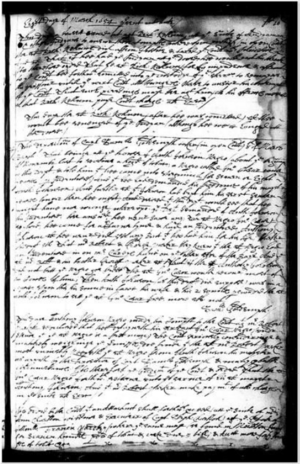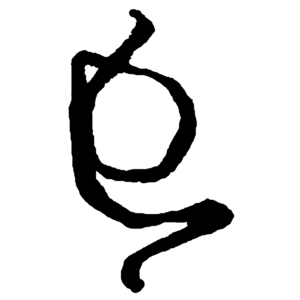Anthony Johnson (colonist) facts for kids
Quick facts for kids
Anthony Johnson
|
|
|---|---|
| Born | c. 1600 Portuguese Angola
|
| Died | 1670 (aged 69–70) |
| Other names | Antonio |
| Occupation | Farmer |
| Known for | The most prominent early colonial black person to own a slave. |
Anthony Johnson (c. 1600 – 1670) was a black man from Portuguese Angola. He became very successful in the early 1600s in the Colony of Virginia. He was one of the first African Americans to have the right to own a servant for life, as decided by the Virginia courts.
He arrived in Virginia in 1621 as an indentured servant. This meant he worked for a set number of years to pay for his journey and living costs. After earning his freedom, he was given land by the colony. He later became a rich tobacco farmer in Maryland. People have called him "the black patriarch" because he was a leader among the first black property owners in America.
Contents
Biography
Early Life and Arrival in Virginia
Around the early 1620s, slave traders captured the man who would become Anthony Johnson in Portuguese Angola. They named him Antonio and sold him into the Atlantic slave trade. A colonist in Virginia bought Antonio. He worked as an indentured servant for a merchant at the Virginia Company.
Antonio sailed to Virginia in 1621 on a ship called the James. A census from 1624 listed him as "Antonio not given," noting he was "a Negro." Historians believe this was likely the same Antonio who later became Anthony Johnson.
Antonio was sold to a white farmer named Bennet. He worked on Bennet's tobacco farm in Virginia. At this time, laws about slavery were not yet fully set in Virginia. Africans were often held as indentured servants, just like many white workers. These servants usually worked for four to seven years to pay off their travel and living costs. After their contract ended, they would become free and often receive land or tools.
Antonio almost died in the Indian massacre of 1622. This happened when the Powhatan people, who were indigenous to the area, attacked Bennet's farm. They were trying to make the colonists leave. Fifty-two of the 57 men there were killed.
In 1623, a black woman named Mary arrived on a ship called the Margaret. She came to work on the same farm as Antonio. Antonio and Mary married and stayed together for over forty years.
Becoming Free and a Landowner
After 1635, Antonio and Mary finished their time as indentured servants. Antonio changed his name to Anthony Johnson. He first appeared in legal records as a free man in 1647 when he bought a calf.
The colonial government gave Johnson a large piece of farmland. He got this land after he completed his indentured contract. On July 24, 1651, he gained 250 acres (about 100 hectares) of land. He did this by buying the contracts of five indentured servants, including his son Richard Johnson. This system was called the headright system. If someone brought indentured servants to the colonies, they received 50 acres for each servant.
Johnson's land was located on the Great Naswattock Creek in Northampton County, Virginia. He ran his own tobacco farm with his own indentured servants. One of these servants, John Casor, would later become one of the first African men declared a servant for life.
In 1652, a fire caused "great losses" for the Johnson family. Johnson asked the courts for tax help. The court lowered his family's taxes. On February 28, 1652, his wife Mary and their two daughters were completely excused from paying taxes for the rest of their lives. At that time, taxes were placed on people, not property. It's not clear why the Johnson women were excused, but it gave them the same social standing as white women, who were not taxed. The judges noted that Anthony and Mary had lived in Virginia for over thirty years and were respected for their "hard labor and known service."
By the 1650s, Anthony and Mary Johnson farmed 250 acres. Their two sons owned a total of 550 acres.
The Casor Lawsuit
When Anthony Johnson became free, he was known as a "free Negro." He became a successful farmer. In 1651, he owned 250 acres and had five indentured servants. Four were white, and one was black.
In 1653, John Casor, a black indentured servant, said his contract with Johnson had ended seven years earlier. He claimed Johnson was holding him illegally. A neighbor, Robert Parker, stepped in and convinced Johnson to free Casor.
Parker offered Casor work, and Casor signed a new contract with him. Johnson then sued Parker in the Northampton Court in 1654 to get Casor back. The court first sided with Parker, but Johnson appealed. In 1655, the court changed its decision. It ruled that Anthony Johnson still "owned" John Casor. The court ordered Casor to be returned to Johnson, and Robert Parker had to pay the court fees.
This was the first time a court in the Thirteen Colonies decided that a person who had not committed a crime could be held as a servant for life.
While Casor was the first person declared a slave in a civil case, some black and white indentured servants were sentenced to lifetime servitude before him. For example, many historians say indentured servant John Punch was the first documented slave for life in America. This happened in 1640 as punishment for trying to escape. This case is seen as one of the first legal decisions to treat black and white indentured servants differently based on their race.
Why the Casor Lawsuit Was Important
The Casor lawsuit shows how people thought in the mid-1600s. Casor believed he could get more support from his new employer, Robert Parker, than Johnson had from his own supporters. Casor thought the problem was about who was helping whom. This wrong idea led him to lose his case. Johnson, however, knew that the local judges believed in protecting property. The judge sided with Johnson. In later legal issues, race would become an even bigger factor.
The Casor lawsuit also showed how hard it was for Africans who were indentured servants to avoid being forced into slavery. Most Africans could not read and knew little English. Farmers found it easy to make them slaves by saying their contracts were not finished. This is what happened in the Johnson v. Parker case. Even though two white farmers said Casor had finished his contract, the court still ruled for Johnson.
Later Life and Family
In 1657, Johnson's neighbor, Edmund Scarborough, supposedly wrote a fake letter. In this letter, Johnson seemed to agree to a debt. It is not known if this debt was real. Johnson did not fight the case. Johnson could not read or write, so he could not have written the letter. Still, the court gave Scarborough 100 acres (about 40 hectares) of Johnson's land to pay off this supposed "debt."
In this early time, free black people had "relative equality" with white people. About 20% of free black Virginians owned their own homes. In 1662, the Virginia Colony passed a law that said children born in the colony would have the same social status as their mother. This meant that children of slave women were born into slavery, even if their fathers were free, European, or white. This was different from English law, which said children took their father's status. The Virginia government said that since Africans were not Christians, English law did not apply to them.
Anthony Johnson moved his family to Somerset County, Maryland. There, he rented a 300-acre (about 120 hectares) piece of land for 99 years. He developed this land into a tobacco farm and named it Tories Vineyards.
Mary, his wife, lived longer than him. In 1672, she gave a cow to each of her grandsons in her will.
Records show that when Johnson died in 1670, his farm was given to a white colonist, not to Johnson's children. A judge had ruled that he was "not a citizen of the colony" because he was black.
In 1677, Anthony and Mary's grandson, John Jr., bought a 44-acre (about 18 hectares) farm he named Angola. However, John Jr. died without children. By 1730, the Johnson family was no longer a major part of history in that area. Some of Anthony's other family members may have moved to Delaware and North Carolina.
See also
 In Spanish: Anthony Johnson (colono) para niños
In Spanish: Anthony Johnson (colono) para niños



